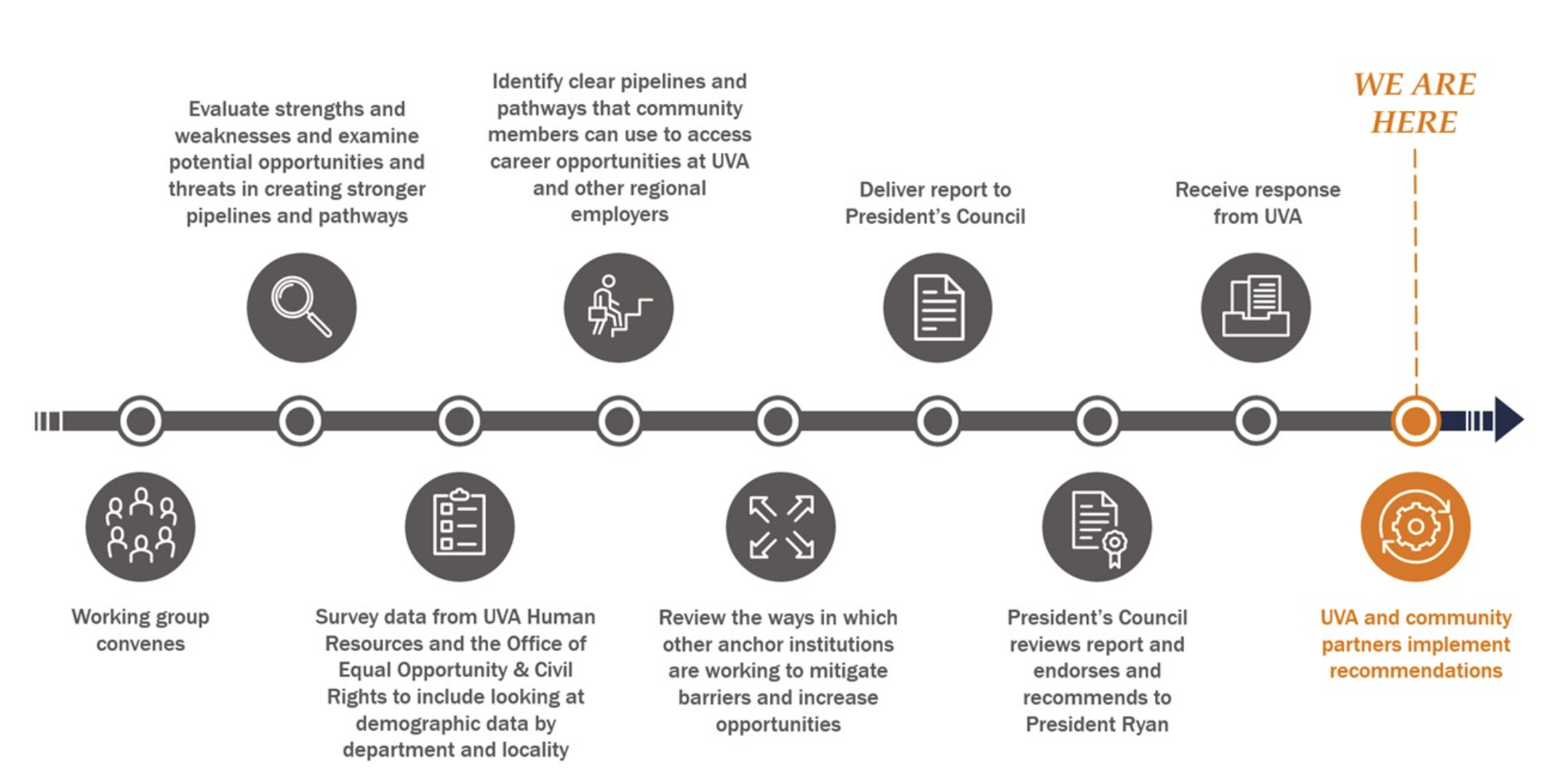Working Group Members
Ridge Schuyler, Dean of Community Self-Sufficiency Programs, PVCC, President’s Council Liaison, working group co-chair
Martha Trujillo, Habitat for Humanity, working group co-chair
Michael Latsko, Senior Director, HR Strategic Initiatives, UVA
Dawn Niles, Community Relations, UVA Health
Richard Hopkins, UVA frontline supervisor
Tobiyah Morris, Employment Equity Specialist at UVA
Kaye Monroe, Virginia Department of Aging and Rehabilitative Services
Shymora Cooper, Community Housing Partners
Martize Tolbert, Community Partner Navigator, The Fountain Fund
John Kosky, Assistant Vice President, HR Impact & Decision support, UVA
Hollie Lee, Program Director, Certificates, UVA
Siri Russell, Director, Office of Equity & Inclusion, Albemarle County
Roy Fitch Jr., Community Engagement Coordinator, Downtown Job Center
Charge
Goal: Increase the number of disadvantaged community residents hired by the University, decrease the rate of turnover, and increase the number of incumbent Academic Division and UVA Health workers, including UVA-affiliated workers (UPG, UVA Temps, etc.) who advance up the income ladder. As part of this work, review and refine guidelines that will ensure equitable access to available jobs by community residents.
Scope of Work
University Employees
- Gather data regarding the current geographic, demographic and racial/ethnic profile of University employees in order to establish a baseline for determining whether progress is being made toward the goal. Sort data by other helpful segments including position type (e.g., frontline, mid-level, leadership) and compensation, including merit raises and performance reviews, and current residence.
- Understand existing hiring practices, including methods of recruitment, job requirements and the application process, and identify barriers to access for different categories of job applicants.
- Inventory and rank University positions with the highest turnover rates, identify the primary causes of departures and terminations for different categories of employees, and review current efforts to address turnover.
- Identify opportunities for career advancement, including methods of recruitment and job requirements, focusing on high demand positions that are recruited from the local geographic area, pay in the $40,000-$47,000 range, and meet criteria mutually agreed by the work group and UVA Human Resources in order to identify barriers to promotion and increase upward career advancement.
- Develop approach to understand barriers to hiring, retention and career advancement in order to make recommendations for improvement. Barriers include, but are not limited to, changing the mindsets of hiring managers as it relates to disadvantaged populations.
- Investigate and recommend strategies that address the challenge of gaining more valuable skills while supporting a household.
University contract workers
- Engage with contractors and employees to understand barriers and opportunities related to recruiting, hiring, and retaining employees.
- Inventory opportunities for career advancement, both within the contract employers and at UVA, to include a pathway from being a contract worker to becoming a University employee.
Deliverables
1. Final Report to include elements described in the scope of work above, including: equity-related data regarding employees and applicants, results of the review of hiring practices, results of the inventory of employee retention and current efforts to reduce turnover, results of the inventory of career advancement and current efforts to increase promotion, findings from consultation, identification of barriers and final recommendations to address barriers.
2. Develop recommendations for a phased approach of actionable items for achieving the goal that could be achieved in the near, medium and long term. The recommendations should address, among other things, resources needed and timeline to implement recommendations.
Required Considerations
The final recommendations should address how the University can increase relationships with community-based organizations and local residents to recruit and retain underrepresented racial and ethnic groups, as well as criminal-justice involved individuals (disaggregated by group, gender, and criminal justice involvement), and should also include resources needed to achieve the recommendations.
Timeline
